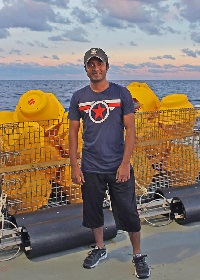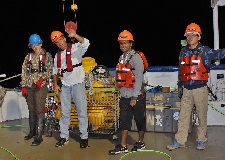
Sakib stands on the deck of the R/V Pelican during LADC-GEMM’s 2015 recovery cruise. (Photo by Natalia Sidorovskaia)
Environmental stressors can cause changes in the abundance and location of certain marine mammal species, which can affect future populations. Researchers can track marine mammals using the number of vocalizations or clicks picked up by acoustic monitoring systems, which can provide insights into their recovery from environmental stressors and, more broadly, deep-water ecosystem health.
Sakib Mahmud tests combinations of passive acoustic monitoring equipment to find the best method to detect and measure marine mammal populations affected by the Deepwater Horizon oil spill. His findings will help improve our understanding of long-term environmental impacts of the spill on deep-diving marine mammals and aid in improving oil spill regulations, monitoring, and mitigation efforts.
Sakib is a master’s student in the University of Louisiana at Lafayette (UL Lafayette) physics program and GoMRI Scholar with the Littoral Acoustic Demonstration Center – Gulf Ecological Monitoring and Modeling (LADC-GEMM) consortium.
His Path
Sakib’s love for nature began in his childhood home of Bangladesh, a nation whose diverse ecosystems face adverse effects of climate change. He watched documentaries to learn more about science, engineering, and conservation work aimed at protecting Earth’s creatures. “Continuously increasing natural and man-made stress endangers many animals and marine species,” he said.
Sakib’s desire to explore and protect nature led him to pursue a bachelors and his first master’s degree in physics at Shahjalal University of Science and Technology, Bangladesh. While there, he volunteered as a researcher at the Atomic Energy Establishment. He began a second masters’ degree in physics at UL Lafayette and took a research assistantship with Dr. Natalia Sidorovskaia, the director of LADC-GEMM. “[The environmental issues in Bangladesh] motivate me to engage in research here, learn, and in the future go back to my country and work there,” said Sakib. “I was always searching for an opportunity to join a community like the Gulf of Mexico Research Initiative, who is working to protect nature and endangered animals.”
His Work

Sakib presents his research at a poster session during the 2017 Gulf of Mexico Oil Spill and Ecosystem Science Conference. (Photo by Md Istiaq Hossain)
Bottom-moored buoys and autonomous surface vehicles (ASVs) are two platforms that perform passive acoustics monitoring of cetaceans; however, there has been no comparative analysis of these platforms. Sakib seeks to fill this gap by comparing data collected by a bottom-moored Environmental Acoustic Recording System (EARS) buoy and an ASV to investigate the relative detection efficiency of those platforms. The EARS buoys in Sakib’s study use LADC-GEMM’s built-in energy detector script that identifies and counts particular species’ acoustic signals to estimate their regional abundance. The ASVs use an open-source marine mammal detection software called PamGuard able to log marine mammal distribution and migration.
Sakib runs the EARS and ASV detector scripts separately to obtain comparative data from each platform. He also modified the EARS buoys’ LADC-GEMM energy detector script to be capable of processing both EARS and ASV data, which will allow him to compare the efficiency of platforms using either EARS buoys or ASVs. “We compare the number of sperm whale clicks detected per minute by each platform’s independent detectors with the modified LADC-GEMM energy detector,” said Sakib. He and his team are currently investigating the density distribution of sperm whales.
Sakib’s trials to date have shown that passive acoustics monitoring platforms using EARS buoys and ASVs have comparable efficiency. Researchers and responders will be able to use the monitoring systems that Sakib is testing to establish more accurate baseline data for regional sperm whale populations and monitor their post-spill recovery. The potential advancements to passive acoustic data collection and processing could also have broader applications identifying relationships between regional abundance variations and long- and short-term environmental factors, such as oil spills and changing weather conditions.
His Learning

(L-R) Kun Li, Natalia Sidorovskaia, Sakib, and Tingting Tang monitor acoustics signals in the R/V Pelican’s dry lab during LADC-GEMM’s 2015 recovery cruise. (Photo by Douglas Dugas)
Being a member of the LADC-GEMM research team has given Sakib the opportunity to work with leading scientists in his field, attend scientific conferences, and gain a better understanding about the research process, which he describes as a “dream come true.” He feels most honored to work alongside Sidorovskaia, whose mentorship has taught him skills from processing bioacoustics data to presenting his results. He recalls an especially memorable experience during the 2015 LADC-GEMM research cruise, “I had never seen dolphins playing in the open ocean before. While we didn’t directly see any whales, we set hydrophones and detected whales clicking in real-time throughout the whole night. It was amazing.”
His Future
Sakib plans to pursue a physics Ph.D. after completing his masters’ and use his education to improve the future conditions of Bangladesh ecosystems. He advises students considering a scientific career to explore the world around them and find a field that sparks passion. “People think scientists are all work and no fun. This is not true – we are always having fun as we discover new things about the world around us!” he said. “There are limitless possibilities with scientific research, and everyone can find an aspect of science that they enjoy.”
Praise for Sakib

(L-R) Marah Dahn, Sean Griffin, Sakib, and Kun Li recover an EARS-Bouy during the 2016 LADC-GEMM recovery cruise. (Photo by Natalia Sidorovskaia)
Dr. Natalia Sidorovskaia described Sakib as someone who is dependable, ready to help, and independent when tackling difficult and unexplored problems. She said that he is a simultaneously adaptive and loyal person who, despite having to quickly adapt to a new educational system and new professional and secular culture, maintains admirable loyalty to the roots of his native culture and religion. She said, “He is great to work with in many settings: by a computer or on a research ship on the open ocean. I wish him the very best in attaining professional and personal horizons he dreams about and making a positive impact on science and people around him.”
The GoMRI community embraces bright and dedicated students like Sakib Mahmud and their important contributions. The GoMRI Scholars Program recognizes graduate students whose work focuses on GoMRI-funded projects and builds community for the next generation of ocean science professionals. Visit the LADC-GEMM website to learn more about their work.
************
The Gulf of Mexico Research Initiative (GoMRI) is a 10-year independent research program established to study the effect, and the potential associated impact, of hydrocarbon releases on the environment and public health, as well as to develop improved spill mitigation, oil detection, characterization and remediation technologies. An independent and academic 20-member Research Board makes the funding and research direction decisions to ensure the intellectual quality, effectiveness and academic independence of the GoMRI research. All research data, findings and publications will be made publicly available. The program was established through a $500 million financial commitment from BP. For more information, visit http://gulfresearchinitiative.org/.
© Copyright 2010- 2017 Gulf of Mexico Research Initiative (GoMRI) – All Rights Reserved. Redistribution is encouraged with acknowledgement to the Gulf of Mexico Research Initiative (GoMRI). Please credit images and/or videos as done in each article. Questions? Contact web-content editor Nilde “Maggie” Dannreuther, Northern Gulf Institute, Mississippi State University (maggied@ngi.msstate.edu).
